ডিমের ট্রে ডিমের প্যাকেজিং এবং পরিবহনে একটি গুরুত্বপূর্ণ ভূমিকা পালন করে, যা তাদের খামার, সুপারমার্কেট এবং খাদ্য প্রক্রিয়াকরণ শিল্পে অপরিহার্য করে তোলে।
সজ্জা এবং বর্জ্য কাগজের মতো পরিবেশ বান্ধব উপকরণ থেকে তৈরি, ডিমের ট্রে শকপ্রুফ, পরিবেশ বান্ধব এবং সহজেই পুনর্ব্যবহারযোগ্য। বাজারে ডিমের ট্রেগুলির ক্রমবর্ধমান চাহিদার সাথে, উত্পাদন দক্ষতা উন্নত করা এবং পণ্যের গুণমান নিশ্চিত করা ব্যবসার জন্য মূল ফোকাস হয়ে উঠেছে।
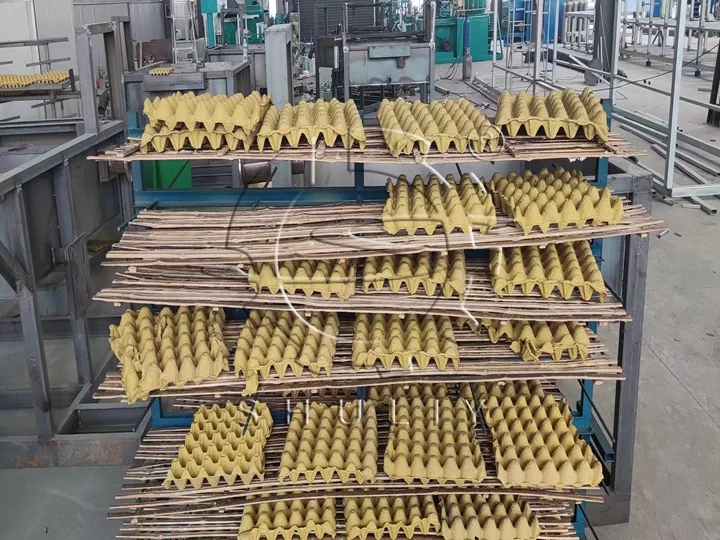
ডিমের ট্রে উৎপাদনের বাজার সম্ভাবনা
ডিমের ব্যবহার বিশ্বব্যাপী বৃদ্ধির সাথে সাথে ডিমের ট্রের চাহিদাও ক্রমাগত বাড়ছে। উপরন্তু, পরিবেশগত সুরক্ষা এবং খাদ্য নিরাপত্তা উদ্বেগের ক্রমবর্ধমান সচেতনতা ভোক্তাদের পরিবেশ বান্ধব ডিমের ট্রে পছন্দ করতে পরিচালিত করেছে।
এই প্রবণতার সাথে খাপ খাইয়ে নেওয়ার জন্য, কোম্পানিগুলিকে অবশ্যই ক্রমাগত উত্পাদন দক্ষতা উন্নত করতে হবে এবং বাজারে প্রতিযোগিতামূলক থাকার জন্য খরচ কমাতে হবে।
উৎপাদন প্রক্রিয়া বৃদ্ধি করে এবং কর্মপ্রবাহকে অপ্টিমাইজ করে, ব্যবসাগুলি উচ্চ-মানের, পরিবেশ বান্ধব পণ্য সরবরাহ করার সময় বাজারের চাহিদা পূরণ করতে পারে, যার ফলে একটি ক্রমবর্ধমান প্রতিযোগিতামূলক বাজারে একটি শক্তিশালী অবস্থান নিশ্চিত করা যায়।
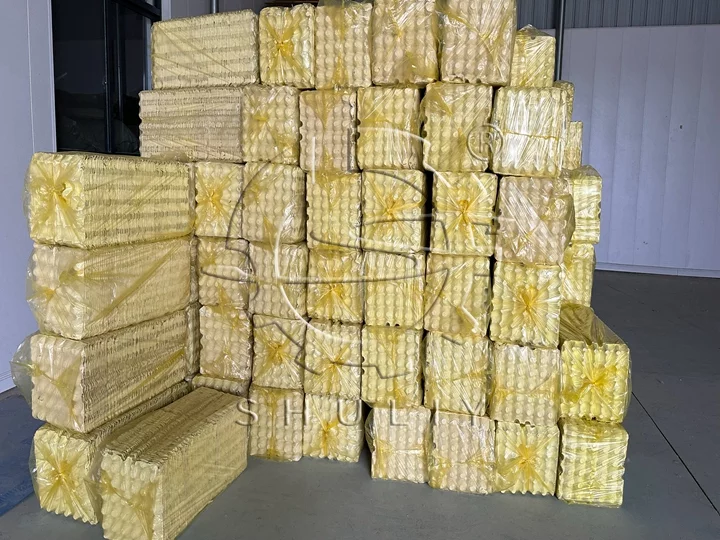

ডিমের ট্রে উত্পাদন সরঞ্জামের প্রকার
দক্ষ উত্পাদন অর্জনের জন্য, একটি ডিমের ট্রে উত্পাদন লাইনে সাধারণত বিভিন্ন ধরণের সরঞ্জাম থাকে, যার মধ্যে রয়েছে:
- পাপিং মেশিন. বর্জ্য কাগজ এবং জল সজ্জা মধ্যে মেশানো ব্যবহৃত.
- ছাঁচনির্মাণ মেশিন. ডিমের ট্রেতে পাল্পের আকার দিন।
- শুকানোর মেশিন. ঝালাই করা ডিমের ট্রে শুকিয়ে তাদের শক্তি নিশ্চিত করে।
- গরম প্রেসিং মেশিন. স্থায়িত্ব বাড়ানোর জন্য ডিমের ট্রেগুলিকে আরও কম্প্যাক্ট করুন।
- প্যাকিং মেশিন. স্বয়ংক্রিয়ভাবে স্ট্যাক, বাছাই, এবং সহজ পরিবহন এবং স্টোরেজ জন্য সমাপ্ত ডিম ট্রে প্যাকেজ.
সঠিকভাবে সরঞ্জামের এই টুকরা কনফিগার করে, উত্পাদন দক্ষতা কার্যকরভাবে বৃদ্ধি করা যেতে পারে। কোম্পানিগুলি তাদের উৎপাদন চাহিদার উপর ভিত্তি করে পৃথক মেশিন বা একটি সম্পূর্ণ উৎপাদন লাইন বেছে নিতে পারে।
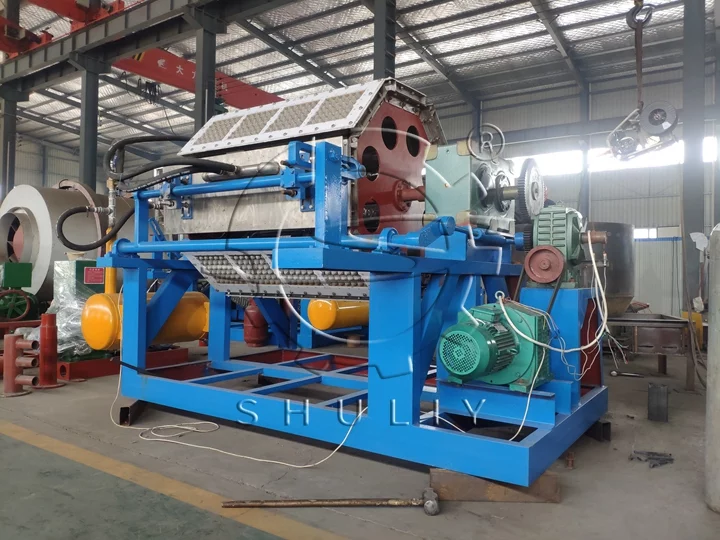
সরঞ্জাম নির্বাচন ছাড়াও, সঠিক কাঁচামাল নির্বাচন করা উত্পাদন অপ্টিমাইজ করার জন্য অত্যন্ত গুরুত্বপূর্ণ।
ডিমের ট্রে উত্পাদন দক্ষতা উন্নত করার মূল কারণ
1. উচ্চ মানের কাঁচামাল নির্বাচন করা
দক্ষ ডিমের ট্রে উৎপাদনের ভিত্তি সঠিক কাঁচামাল নির্বাচনের মাধ্যমে শুরু হয়। পরিষ্কার বর্জ্য কাগজ এবং পিচবোর্ড আদর্শ কারণ তারা আরো সহজে সজ্জা এবং চমৎকার বন্ধন বৈশিষ্ট্য প্রস্তাব.
এটি নিশ্চিত করে যে সজ্জার সামঞ্জস্য টেকসই এবং উচ্চ-মানের ডিমের ট্রে তৈরির জন্য সর্বোত্তম। ন্যূনতম অমেধ্য সহ উপকরণ ব্যবহার করা অত্যন্ত গুরুত্বপূর্ণ, কারণ অমেধ্য ট্রেগুলিকে দুর্বল করতে পারে এবং উত্পাদন প্রক্রিয়াকে ব্যাহত করতে পারে।


2. সরঞ্জাম নির্বাচন এবং সাইট লেআউট অপ্টিমাইজ করা
দক্ষ উৎপাদন শুধু ভালো যন্ত্রপাতি থাকাই নয়; এটি কৌশলগত সরঞ্জাম স্থাপন এবং সাইট বিন্যাস জড়িত. উপরন্তু, ভাল বায়ুচলাচল এবং পরিবেশগত সুরক্ষা সুবিধাগুলি উত্পাদন পরিবেশের গুণমান উন্নত করতে পারে, নিরাপত্তা এবং স্থায়িত্ব নিশ্চিত করতে পারে।
এর পরে, আমরা কীভাবে আপনার ডিমের ট্রে উত্পাদন উন্নত করতে পারি তা পরিচয় করিয়ে দেব।
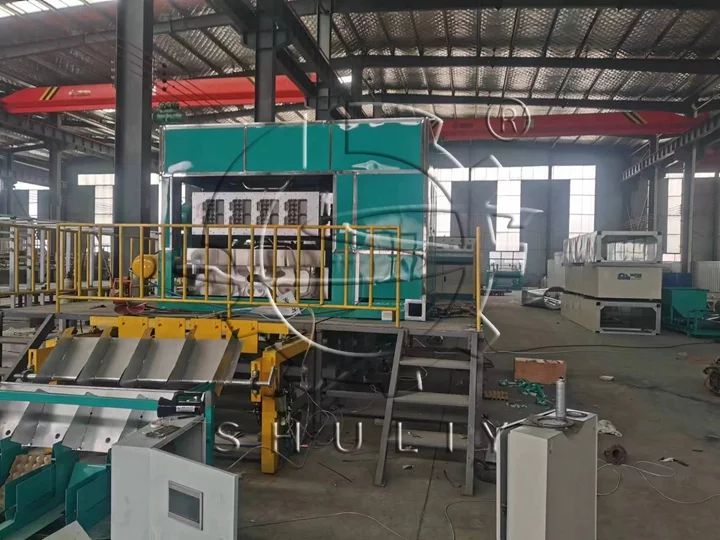
কাগজ শক্ত কাগজ উত্পাদন প্রক্রিয়া অপ্টিমাইজ করা
ডিমের ট্রে উৎপাদনে দক্ষতা বাড়ানোর জন্য, প্রক্রিয়াটি পরিমার্জন করার জন্য উচ্চ-মানের যন্ত্রপাতি ছাড়াও আরও অনেক কিছু জড়িত। সর্বোত্তম কর্মক্ষমতা অর্জনের জন্য এখানে একটি কাঠামোগত পদ্ধতি রয়েছে:
1. কৌশলগত সরঞ্জাম বিন্যাস
- ছাঁচনির্মাণ থেকে pulping. মোল্ডিং মেশিনের কাছাকাছি পাল্পিং মেশিন রাখুন। এটি দূরত্ব দূরত্ব কমিয়ে দেয়, যা পরিবহন সময় এবং শক্তি খরচ কমায়।
- শুকানোর জন্য ছাঁচনির্মাণ। ছাঁচনির্মাণ মেশিনের পরপরই শুকানোর মেশিনটি রাখুন। এই সেটআপটি ভিজা থেকে শুষ্ক পর্যায়ে একটি মসৃণ রূপান্তর নিশ্চিত করে, অপ্রয়োজনীয় হ্যান্ডলিং এবং সম্ভাব্য বিলম্ব হ্রাস করে।
কার্যকরী সরঞ্জাম বিন্যাস একটি ক্রমাগত প্রবাহ বজায় রাখতে সাহায্য করে, বাধা হ্রাস করে এবং সামগ্রিক উত্পাদন গতি বাড়ায়।

2. নিয়মিত সরঞ্জাম রক্ষণাবেক্ষণ
- নির্ধারিত পরিদর্শন. ভ্যাকুয়াম পাম্প এবং ছাঁচনির্মাণ সিস্টেমের মতো জটিল মেশিনগুলিতে ঘন ঘন চেক পরিচালনা করুন। নিয়মিত পরিদর্শন অপ্রত্যাশিত ভাঙ্গন প্রতিরোধ করতে সাহায্য করে।
- সময়মত মেরামত. উত্পাদন বন্ধ এড়াতে এবং যন্ত্রপাতির আয়ু বাড়াতে রক্ষণাবেক্ষণের সমস্যাগুলি অবিলম্বে সমাধান করুন। এই সক্রিয় পদ্ধতির ধারাবাহিক পণ্যের গুণমান নিশ্চিত করে এবং ডাউনটাইম হ্রাস করে।
মসৃণ অপারেশন এবং উচ্চ-মানের আউটপুটের জন্য রুটিন রক্ষণাবেক্ষণ অপরিহার্য।
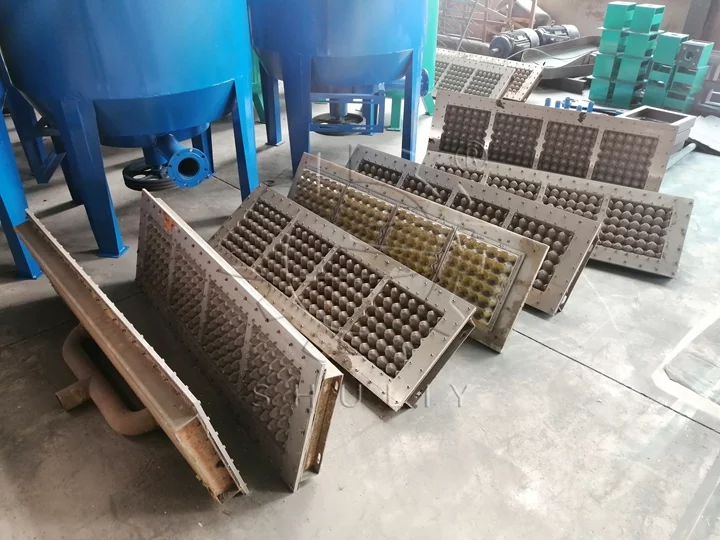
3. দক্ষ কর্মী বরাদ্দ
- নিবেদিত অপারেটর. উত্পাদন লাইনের প্রতিটি পর্যায়ে নির্দিষ্ট অপারেটরদের বরাদ্দ করুন - পাল্পিং, ছাঁচনির্মাণ এবং শুকানো। বিশেষায়িত কর্মীরা তাদের বিভাগগুলি কার্যকরভাবে পরিচালনা করতে পারে এবং সমস্যাগুলি দ্রুত সমাধান করতে পারে।
- সমস্যার সমাধান। বড় ধরনের বিঘ্ন এড়াতে ছোটখাটো সমস্যা দ্রুত শনাক্ত করতে এবং সমাধান করতে কর্মীদের প্রশিক্ষণ দিন। এই টার্গেটেড স্টাফিং পদ্ধতি নিশ্চিত করে যে উত্পাদন প্রক্রিয়ার প্রতিটি অংশ সুচারুভাবে কাজ করে।
যথাযথ কর্মী বরাদ্দ নিশ্চিত করে যে প্রতিটি উত্পাদন পর্যায় নিবিড়ভাবে পর্যবেক্ষণ করা হয়, দক্ষতা এবং পণ্যের গুণমান উভয়ই উন্নত করে।
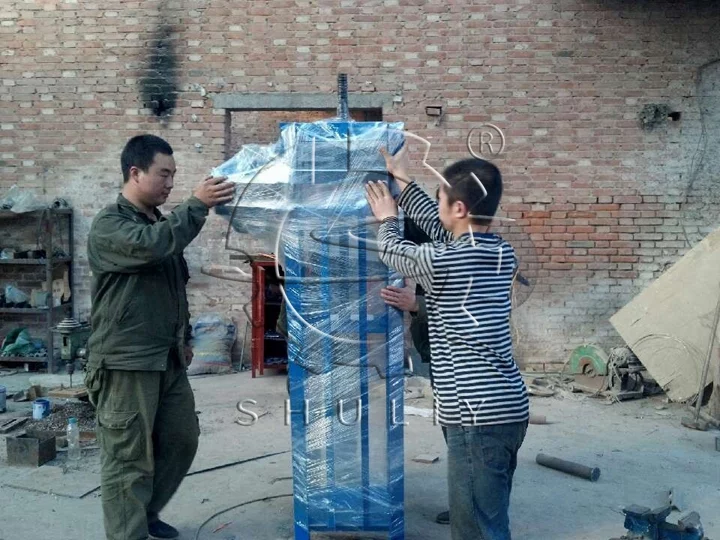
একটি কৌশলগত সরঞ্জাম বিন্যাস, কঠোর রক্ষণাবেক্ষণ, এবং ভালভাবে বরাদ্দকৃত কর্মীদের একীভূত করে, আপনি ডিমের ট্রে উত্পাদন প্রক্রিয়াটিকে অপ্টিমাইজ করতে পারেন, উচ্চ-মানের মান বজায় রেখে বাজারের চাহিদা পূরণ করতে পারেন।
উচ্চ মানের ডিম ট্রে জন্য প্রযুক্তিগত প্রয়োজনীয়তা
উচ্চ-মানের ডিমের ট্রে উত্পাদন নির্ভরযোগ্য উত্পাদন সরঞ্জাম এবং কার্যকর ব্যবস্থাপনার বাইরে যায়; এটি স্থায়িত্ব এবং কার্যকারিতা নিশ্চিত করতে নির্দিষ্ট প্রযুক্তিগত মান মেনে চলারও দাবি করে। শীর্ষস্থানীয় ডিমের ট্রে তৈরির জন্য এখানে মূল প্রযুক্তিগত প্রয়োজনীয়তা রয়েছে:
1. সর্বোত্তম আর্দ্রতা সামগ্রী
ডিমের ট্রে উৎপাদনে সঠিক আর্দ্রতার মাত্রা বজায় রাখা অত্যন্ত গুরুত্বপূর্ণ। সঠিক ছাঁচনির্মাণ এবং গঠনের সুবিধার্থে পাল্পিং পর্যায়ে সজ্জার আর্দ্রতা 50-60%-এর মধ্যে নিয়ন্ত্রণ করা উচিত। ছাঁচনির্মাণের পরে, ডিমের ট্রেগুলির আর্দ্রতার পরিমাণ 10%-এর নীচে কমিয়ে আনতে হবে যাতে সেগুলি পর্যাপ্ত পরিমাণে শুকিয়ে যায় এবং পরিচালনা এবং পরিবহনের জন্য যথেষ্ট শক্তিশালী হয়।
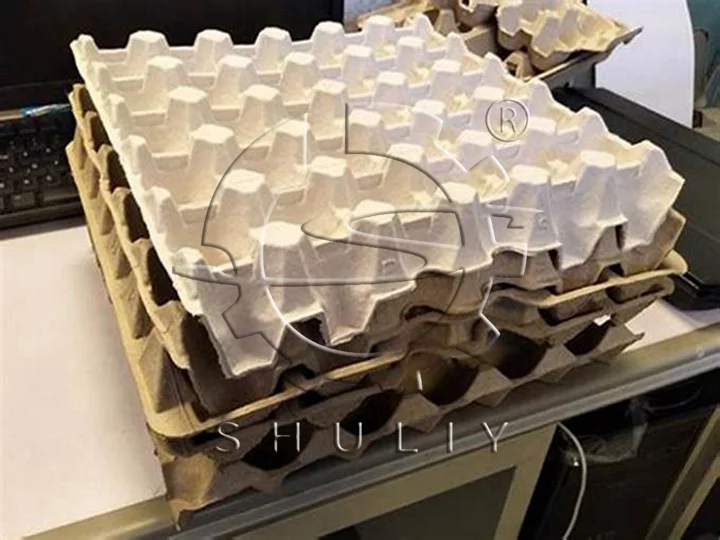
2. সামঞ্জস্যপূর্ণ বেধ
সমস্ত ডিমের ট্রে জুড়ে অভিন্ন বেধ তাদের শক-শোষণ ক্ষমতা নিশ্চিত করার জন্য অপরিহার্য। এমনকি বেধ ওজন সমানভাবে বিতরণ করতে সাহায্য করে, পরিবহনের সময় ডিমের জন্য আরও ভাল সুরক্ষা প্রদান করে। ঘনত্বের সামঞ্জস্যতা দুর্বল দাগের সম্ভাবনাও হ্রাস করে, যা চাপের অধীনে ভাঙ্গন বা বিকৃতি হতে পারে।
3. উচ্চ কম্প্রেসিভ শক্তি
স্ট্যাকিং, হ্যান্ডলিং এবং পরিবহনের সময় যে চাপের সম্মুখীন হয় তা সহ্য করার জন্য ডিমের ট্রেগুলির উচ্চ সংকোচন শক্তি থাকতে হবে। শক্তিশালী ডিমের ট্রে ডিমগুলিকে ক্ষতিগ্রস্ত বা ফাটতে বাধা দেয়, তাদের গন্তব্যে নিরাপদ ডেলিভারি নিশ্চিত করে। এই স্তরের শক্তি অর্জনের জন্য দুর্বলতা বা ত্রুটিগুলি এড়াতে ছাঁচনির্মাণ এবং শুকানোর প্রক্রিয়াগুলির যত্নশীল নিয়ন্ত্রণ প্রয়োজন।
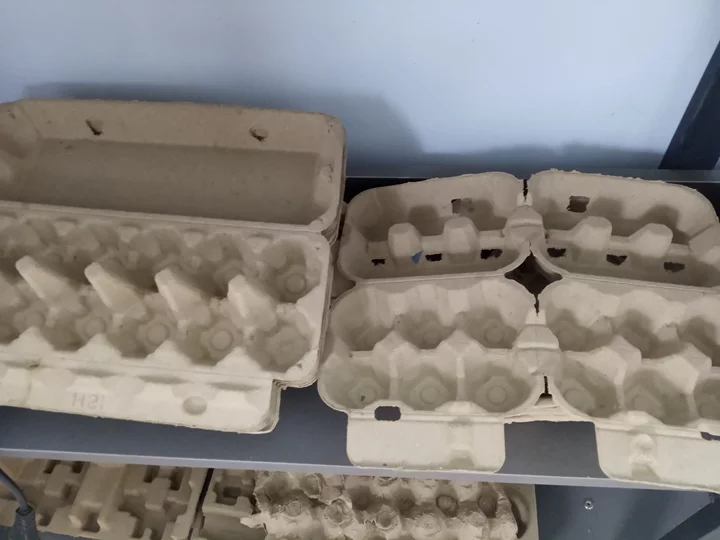
এই প্রযুক্তিগত প্রয়োজনীয়তাগুলি পূরণ করে, নির্মাতারা ডিমের ট্রে তৈরি করতে পারে যা উচ্চতর কর্মক্ষমতা এবং নির্ভরযোগ্যতা প্রদান করে, তাদের বিষয়বস্তুগুলিকে কার্যকরভাবে রক্ষা করে এবং সরবরাহ শৃঙ্খলে কাঠামোগত অখণ্ডতা বজায় রাখে।
ডিম ট্রে মেশিনের কাজের নীতি এবং উত্পাদন প্রক্রিয়া
ডিমের ট্রে মেশিনের কাজের নীতি বোঝা কার্যকরভাবে উত্পাদন সরঞ্জাম পরিচালনা এবং রক্ষণাবেক্ষণের জন্য অপরিহার্য। ডিম ট্রে মেশিনের উত্পাদন প্রক্রিয়া তিনটি প্রধান পর্যায় নিয়ে গঠিত: পাপিং, ছাঁচনির্মাণ এবং শুকানো। প্রতিটি পর্যায়ে অপারেশন এবং সতর্কতা বোঝার মাধ্যমে, কোম্পানিগুলি তাদের সরঞ্জামগুলি আরও ভালভাবে বজায় রাখতে পারে এবং তাদের উত্পাদন প্রক্রিয়াগুলি পরিচালনা করতে পারে।
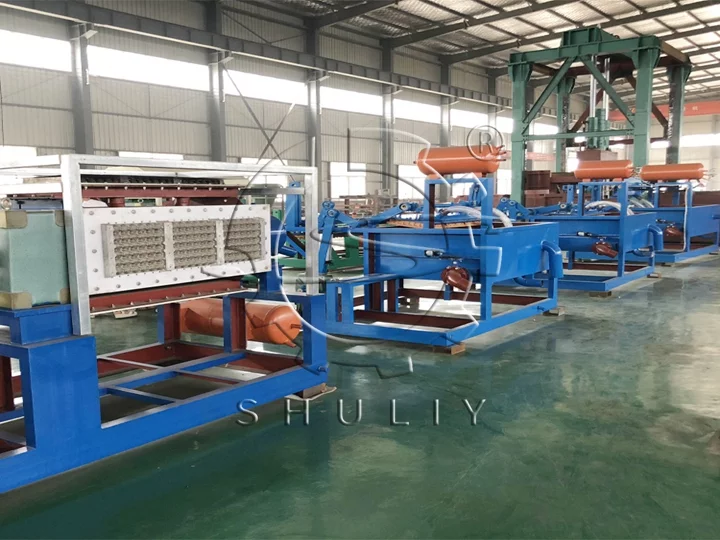
1. পাপিং স্টেজ
পাল্পিং পর্যায়ে, বর্জ্য কাগজ এবং জল পাল্পিং মেশিনে মিশ্রিত হয় যাতে একটি অভিন্ন পাল্প তৈরি হয়। এই সজ্জা তারপর পছন্দসই ধারাবাহিকতা এবং গুণমান অর্জনের জন্য সজ্জা সমন্বয় এবং সরবরাহ পুলগুলিতে বিভিন্ন অপারেশনের মাধ্যমে প্রক্রিয়া করা হয়। এই পর্যায়টি সজ্জার অভিন্নতা নিশ্চিত করার জন্য অত্যন্ত গুরুত্বপূর্ণ, যা পরবর্তী ছাঁচনির্মাণ প্রক্রিয়ার জন্য অপরিহার্য।
2. ছাঁচনির্মাণ পর্যায়
ছাঁচনির্মাণের পর্যায়ে, ভ্যাকুয়াম পাম্প দ্বারা উত্পন্ন নেতিবাচক চাপ ব্যবহার করে সজ্জাটি ছাঁচে শোষিত হয়। ভ্যাকুয়াম ডিহাইড্রেশন এবং ইতিবাচক চাপ প্রবাহের মাধ্যমে সজ্জাটি ডিমের ট্রে আকারে তৈরি হয়। এই সুনির্দিষ্ট ক্রিয়াকলাপটি ডিমের ট্রেগুলির সমান বেধ এবং পর্যাপ্ত শক্তি রয়েছে তা নিশ্চিত করার মূল চাবিকাঠি।
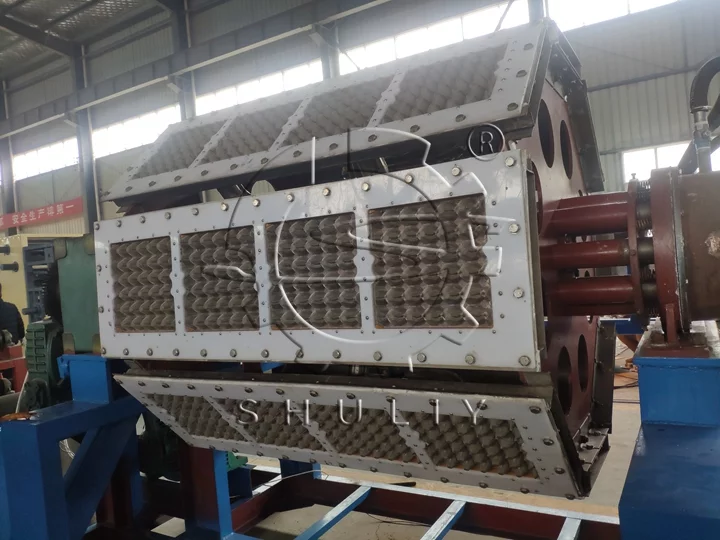
3. শুকানোর পর্যায়
শুকানোর পর্যায়ে, ঢালাই করা ডিমের ট্রেগুলি তাদের শক্তি এবং স্থায়িত্ব নিশ্চিত করতে একটি ড্রাইং মেশিন ব্যবহার করে শুকানো হয়। শুকানোর পরে, ডিমের ট্রেগুলি স্বয়ংক্রিয়ভাবে গণনা করা হয়, স্ট্যাক করা হয় এবং তারপরে স্টোরেজ এবং পরিবহনের জন্য প্যাকেজ করা হয়। উপযুক্ত শুকানোর পদ্ধতি এবং সরঞ্জাম কনফিগারেশন নির্বাচন করা উল্লেখযোগ্যভাবে উত্পাদন দক্ষতা বাড়াতে পারে এবং ডিমের ট্রেগুলির চূড়ান্ত গুণমান নিশ্চিত করতে পারে।
এই উত্পাদন পদক্ষেপগুলি বোঝার মাধ্যমে, সংস্থাগুলি উত্পাদন প্রক্রিয়াটিকে অপ্টিমাইজ করতে এবং দক্ষতা উন্নত করতে পারে। ডিমের ট্রে তৈরিতে সর্বোত্তম ফলাফল অর্জনের জন্য নির্দিষ্ট উৎপাদন চাহিদা অনুযায়ী সঠিক শুকানোর পদ্ধতি এবং সরঞ্জাম কনফিগারেশন নির্বাচন করা অপরিহার্য।
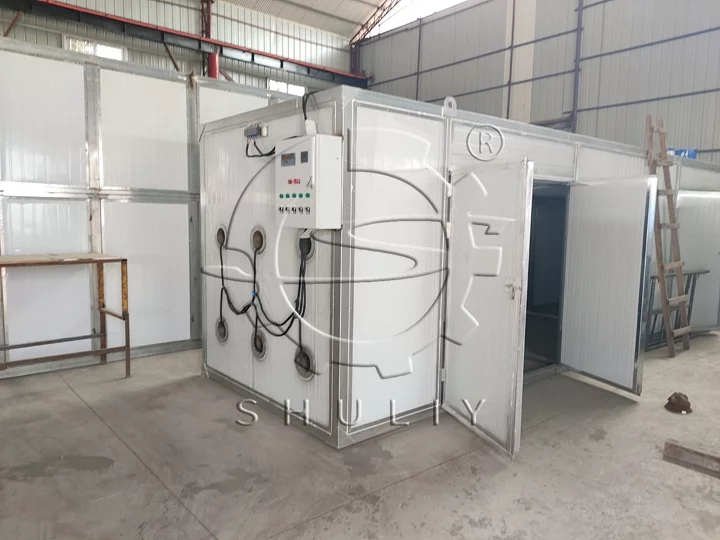
ডিম বাক্স তৈরির প্রক্রিয়া সম্পর্কে প্রায়শই জিজ্ঞাসা করা প্রশ্নাবলী
কাঁচামালে অমেধ্য উপস্থিতি ডিমের ট্রে উৎপাদনকে কীভাবে প্রভাবিত করে?
কাঁচামালে উচ্চ মাত্রার অমেধ্য ডিমের ট্রেগুলির গুণমান এবং শক্তি হ্রাস করতে পারে। এটি মোকাবেলা করার জন্য, সজ্জা গঠনের আগে বৃহত্তর অমেধ্য অপসারণের জন্য একটি স্পন্দিত পর্দা ব্যবহার করা অত্যন্ত গুরুত্বপূর্ণ।
ডিমের ট্রে মেশিনের ছাঁচের সাথে সাধারণ পরিধান এবং টিয়ার সমস্যাগুলি কী এবং কীভাবে সেগুলি পরিচালনা করা যায়?
সাধারণত, ছাঁচ পরিধান ন্যূনতম হয়. সম্ভাব্য পরিধান পরিচালনা করতে এবং উৎপাদনের ধারাবাহিকতা নিশ্চিত করতে, অতিরিক্ত ছাঁচ সেট কেনার কথা বিবেচনা করুন। এইভাবে, আপনি দ্রুত জীর্ণ ছাঁচ প্রতিস্থাপন করতে পারেন এবং উত্পাদন দক্ষতা বজায় রাখতে পারেন।
একটি একক মেশিন কি আদর্শ এবং কাস্টম-আকৃতির ডিমের ট্রে উভয়ই উত্পাদন করতে পারে এবং ছাঁচ প্রতিস্থাপন কীভাবে কাজ করে?
হ্যাঁ, একটি একক মেশিন কেবল ছাঁচ পরিবর্তন করে উভয় স্ট্যান্ডার্ড এবং কাস্টম-আকৃতির ট্রে তৈরি করতে পারে। কাস্টম আকারের জন্য, অতিরিক্ত সরঞ্জাম যেমন একটি তাপ প্রেসের প্রয়োজন হতে পারে। ছাঁচ পরিবর্তনগুলি সহজবোধ্য, উত্পাদনে বহুমুখিতাকে অনুমতি দেয়।
প্রতিযোগীদের তুলনায় আপনার ডিম ট্রে উত্পাদন মেশিন ব্যবহার করার সুবিধা কি কি?
আমাদের মেশিনগুলি উচ্চ কঠোরতা এবং দীর্ঘ জীবনকাল নিশ্চিত করে মানক ইস্পাত উপকরণ ব্যবহার করে। শুকানোর সিস্টেমে স্থায়িত্ব এবং জারা প্রতিরোধের জন্য স্টেইনলেস স্টিলের নির্মাণ বৈশিষ্ট্য রয়েছে। উপরন্তু, আমাদের মেশিনগুলি কার্যকর তাপ ধরে রাখার জন্য এবং কম জ্বালানী খরচের জন্য 100% নিরোধক তুলা ব্যবহার করে।
উপসংহার
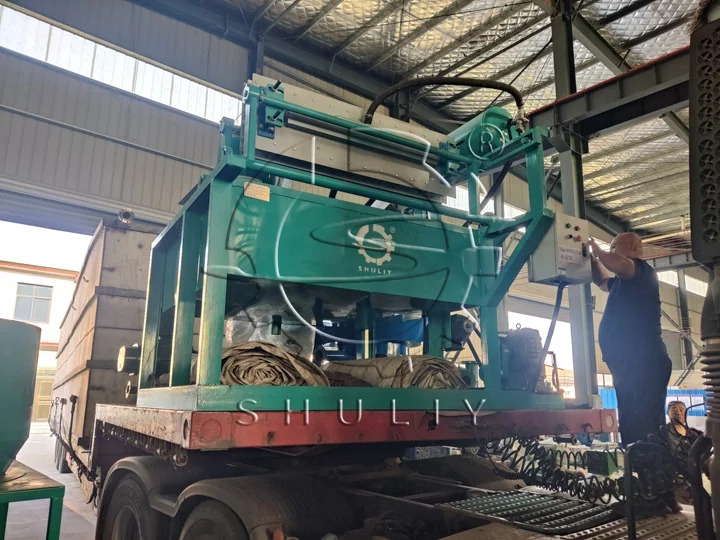
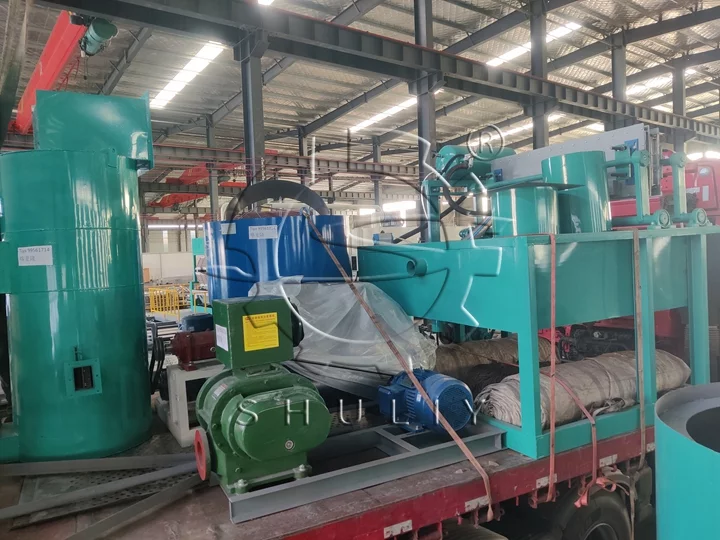
কাঁচামাল সাবধানে নির্বাচন করে, সরঞ্জাম কনফিগারেশন এবং উত্পাদন প্রক্রিয়া অপ্টিমাইজ করে, এবং কর্মী ব্যবস্থাপনা ও সরঞ্জাম রক্ষণাবেক্ষণ উন্নত করে, কোম্পানিগুলি ডিমের ট্রে উত্পাদনের দক্ষতা এবং গুণমান উল্লেখযোগ্যভাবে উন্নত করতে পারে।
একটি প্রতিযোগিতামূলক বাজার পরিবেশে, এই ব্যবস্থাগুলি কোম্পানিগুলিকে গ্রাহকের চাহিদাগুলিকে আরও ভালভাবে পূরণ করতে এবং তাদের বাজারের প্রতিযোগিতা বাড়াতে সাহায্য করবে। আপনি যদি আমাদের ডিম ট্রে উত্পাদন লাইন বা পৃথক মেশিন আগ্রহী হন, আমাদের সাথে যোগাযোগ করুন. আমরা আপনার প্রয়োজনের উপর ভিত্তি করে সেরা সমাধান প্রদান করব।
